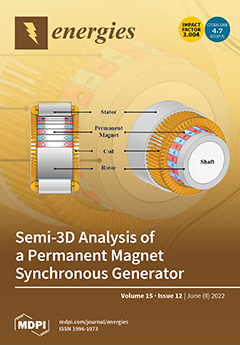In this paper, the effect of house envelopes including thermal bridges on the daily, monthly, and annual consumption of the air conditioning system of a detached house and an attached house, with a façade in the east, west, north, or south direction, is
[...] Read more.
In this paper, the effect of house envelopes including thermal bridges on the daily, monthly, and annual consumption of the air conditioning system of a detached house and an attached house, with a façade in the east, west, north, or south direction, is investigated; moreover, the capacity of the air conditioning system is calculated for detached and attached houses based on the maximum hourly peak load during severe weather conditions. The four tested house envelopes are exterior insulation and finish system (EIFS), autoclaved aerated concrete block (AAC-B), classical (cement blocks with insulation in between), and AAC column and beam (AAC-CB). The work is conducted using a method that combines the finite element method (COMSOL Multiphysics), building simulation (EnergyPlus), and the Engineering Equation Solver (EES) programs. The results indicated that the annual consumption of the air conditioning system using AAC-B, classical, and AAC-CB envelopes is larger than that of EIFS by about 3.74, 11.53, and 20.70% for the detached house, and 1.8, 2.9%, and 6.7% for the attached house, respectively. The annual consumption of the air conditioner of the detached house is larger than the average consumption of the attached house by about 25.3, 27.7, 35.8, and 41.7% for EIFS, AAC-B, classical, and AAC-CB house envelopes, respectively. Using the different façade directions of the attached house, the average effect of the house envelope type on the air conditioning system capacity is about 8.84%, with a standard deviation of 0.466%.
Full article





